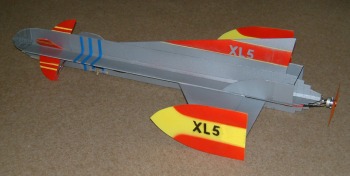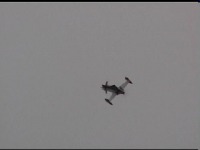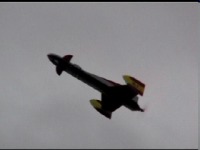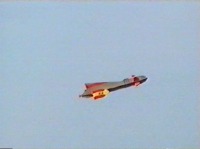FIREBALL XL5 - A FLYING MODEL!!
By Al Foot
Photos by Al Foot
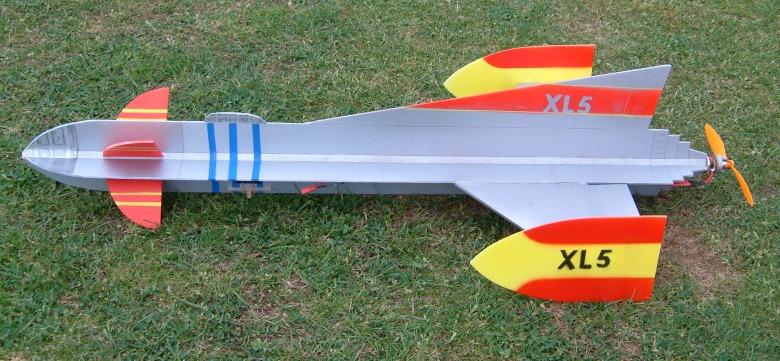
Iíve been a life-long Fireball XL5 enthusiast, and have been reliving
my childhood by watching all of the episodes on the Carlton DVD
collection. Even now, there are some aspects that are ahead of this time,
let alone the 1960ís when the originals were screened.
The main
star of the shows was, without a doubt, Fireball XL5 - a vehicle capable
of flying through atmospheres, leaving the Earth, travelling through space
to other worlds, and returning safely without so much as a singe on the
outside skin!! Obviously a very advanced machine!!
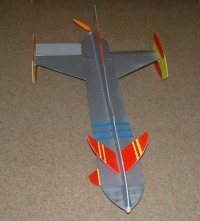 The engineers that designed it must have been advanced
thinkers too, and, with this in mind, I wanted to test the concept by
designing a radio-controlled flying model of XL5. The engineers that designed it must have been advanced
thinkers too, and, with this in mind, I wanted to test the concept by
designing a radio-controlled flying model of XL5.
As you can imagine, there had to be a few compromises in the design to
ensure that she would fly, these being mainly in the wing, fuselage and
fin sections (yes I know thatís basically everything!!). I made the
fuselage as a flat plate side profile and a flat plate top/bottom profile
so that the assembled cross section was, wellÖ a cross!!
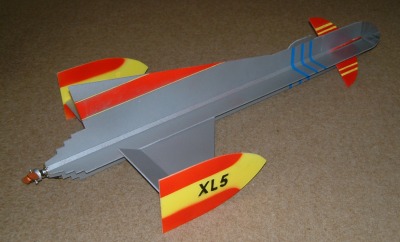 I used Robinís 3-view diagrams of Fireball XL5 as a basis, and,
with my aeromodelling hat on, decided on a model size that would suit the
propulsion and control system that I wanted to use. There have been huge
advances in miniaturisation of radio equipment recently at reasonable
cost. Similarly, electric motor technology for models is evolving at a
pace. I actually make my own motors now, and used one of these to power my
model of XL5. I used Robinís 3-view diagrams of Fireball XL5 as a basis, and,
with my aeromodelling hat on, decided on a model size that would suit the
propulsion and control system that I wanted to use. There have been huge
advances in miniaturisation of radio equipment recently at reasonable
cost. Similarly, electric motor technology for models is evolving at a
pace. I actually make my own motors now, and used one of these to power my
model of XL5.
I tried to remain reasonably faithful to the shape, but please bear in
mind that this is the prototype, and I did not want to invest too much
time and effort. Similarly, the wings, fins and Fireball Junior fins were
all flat plates.
I wonít bore you all with the thinking processes that I went
through before attempting to fly Fireball - suffice to say that the
balance point of the machine needed to be right or else she would be
uncontrollable. Similarly, the aerodynamic means of controlling Fireball
had to be derived since I would not be able to use the thrusters as per
the original!!
She first flew on 9 Sept 2005, after which I had to
add additional fins and rudders to get some measure of control - you can
see these in the photos, but I tried to make them as unobtrusive as
possible. In flight, you hardly notice them at all.
The movies show the
third and fourth flights, before and after adding the additional fins. The
improvement in control is obvious!!
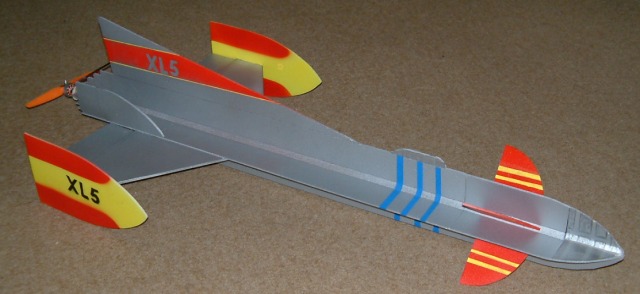
Fireball XL5 has now done about 10 flights, and Iím now
getting used to the somewhat unusual flying characteristics. (For those
that fly radio-controlled aircraft, if you imagine a ďnormalĒ aircraft but
with the fin at the front instead of the back you will not be far from
understanding how Fireball XL5 flies!! ). I hope you agree that she looks
great in the video clips, and it was certainly worth the effort!! She
certainly causes a stir every time that I take her up to the
airfield.
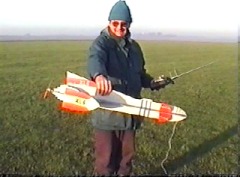
Now that I know that she flies, I intend to add a few more
details, and I might even build another!!
I hope that you enjoy my flying model of Fireball XL5.
Best regards,
Al Foot
| 
 The engineers that designed it must have been advanced
thinkers too, and, with this in mind, I wanted to test the concept by
designing a radio-controlled flying model of XL5.
The engineers that designed it must have been advanced
thinkers too, and, with this in mind, I wanted to test the concept by
designing a radio-controlled flying model of XL5. I used Robinís 3-view diagrams of Fireball XL5 as a basis, and,
with my aeromodelling hat on, decided on a model size that would suit the
propulsion and control system that I wanted to use. There have been huge
advances in miniaturisation of radio equipment recently at reasonable
cost. Similarly, electric motor technology for models is evolving at a
pace. I actually make my own motors now, and used one of these to power my
model of XL5.
I used Robinís 3-view diagrams of Fireball XL5 as a basis, and,
with my aeromodelling hat on, decided on a model size that would suit the
propulsion and control system that I wanted to use. There have been huge
advances in miniaturisation of radio equipment recently at reasonable
cost. Similarly, electric motor technology for models is evolving at a
pace. I actually make my own motors now, and used one of these to power my
model of XL5. 

